Patterns and Possibilities: Denim in Skate Culture
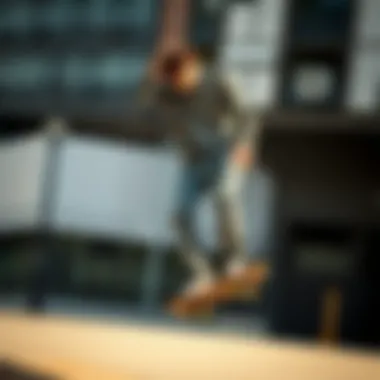
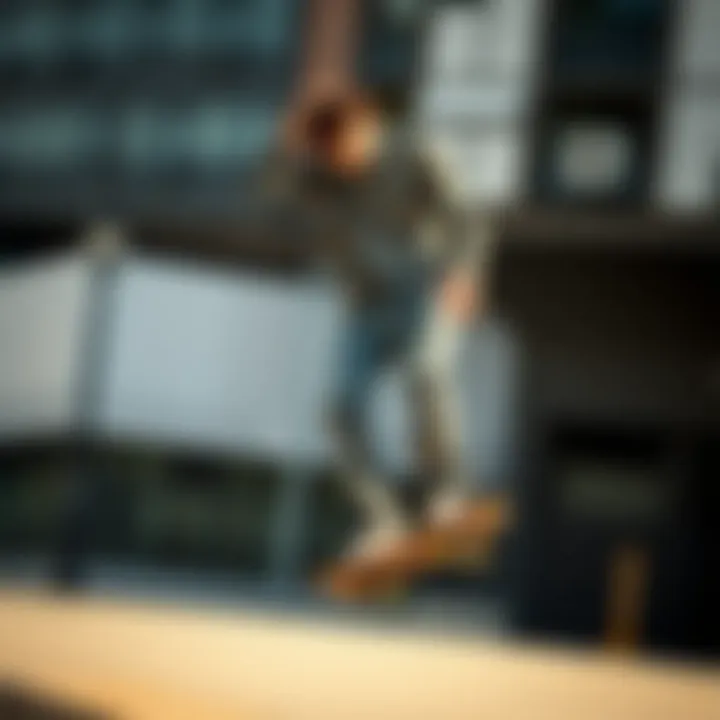
Intro
Denim has ebbed and flowed through various cultural tides, but its role in skate culture has created a unique narrative. Skateboarding, with its rebellious spirit and DIY ethos, formed a distinct appreciation for denim that goes beyond mere clothing. For many skaters, patterned denim isn’t just a fashion statement; it tells a story of who they are and where they belong. This article aims to delve into how these vibrant fabrics have shaped skate culture, their historical underpinnings, and their stylistic evolution within urban landscapes.
Skateboarding itself has been a platform for self-expression and creativity, blending art and sport. The clash of colors, textures, and patterns can often reflect a skater’s identity. With skate parks popping up alongside urban architecture, the patterns on denim jeans have often mirrored the chaos and vibrance of the environments in which skateboarders thrive. By analyzing these patterned denim styles, we glean insights into the community’s values and future aspirations.
Skateboarding Techniques
Exploring skateboarding techniques isn’t just for improving skills; it also intersects with the culture of skate fashion. The denim worn while mastering a trick often stands at the crossroads of comfort and style.
Essential Tricks for Beginners
- Ollie: The fundamental trick that every skater learns. It's all about popping the tail of the board while jumping to lift yourself and the skateboard off the ground. Wearing lighter denim helps enhance flexibility during this initial phase.
- Kickflip: Once you’ve nailed the ollie, the kickflip comes next. It involves flicking the board with your foot while jumping. Skaters often opt for denim with some stretch, allowing for fluid movement.
- Shuvit: A trick that gets the board spinning underneath your feet without the need for a flip. Baggier denim can create room for air, making it easier to maneuver.
Advanced Maneuvers for Seasoned Skaters
As skaters progress, they crave more than just the basics. With that, their denim choices evolve, often reflecting their expertise in the sport.
- Heelflip: Similar to a kickflip but uses the heel to flip the board. Advanced skaters usually seek jeans with reinforced seams to handle the wear and tear.
- Grind: Involves sliding along a rail or ledge and requires durable denim to withstand friction. Skaters with a distinct style may choose unique patterned denim, standing out while showing their skills.
- 540°: This aerial trick requires immense balance and skill. It’s here that denim’s function meets fashion fully, with specialized patterns serving as a statement.
"The unique patterns found in denim not only offer individuality, but they also speak volumes about the skater's personality and journey within the sport."
End on Skateboarding Techniques
As the techniques evolve, so does the fabric and design choices that accompany them. Patterns in denim have become emblematic of commitment to the craft; they reflect a blend of individual style and the shared language of skate culture. The nuanced connection between fashion and function allows the skateboard community to express their narratives, marking their presence on and off the ramp. Ultimately, patterned denim is integral to the broader story of skateboarding—an evolving tapestry woven through generations of skaters.
The Historical Context of Denim
The historical aspect of denim is crucial in understanding how it has woven itself into the fabric of skate culture. Denim is more than mere material; it is a narrative of rebellion, self-expression, and identity that has evolved over time alongside youth movements, especially in skateboarding. By exploring the origins and rise of denim, we unveil the intertwined history of fashion and youth, which sets a backdrop for its pervasive influence in contemporary skate culture.
Origins of Denim Fabric
Denim, as we know it today, was born in the late 17th century. The fabric gets its name from "serge de Nîmes," a sturdy textile woven in the French town of Nîmes. Initially used for work garments, its durability and comfort made it ideal for laborers. However, the turning point came in the 19th century. Levi Strauss, a Bavarian immigrant, recognized the material's potential to cater to the needs of miners during the California Gold Rush. He introduced jeans, which were initially utilitarian pants designed for hard work. With rivets added for extra strength, these pants began making a name for themselves.
Fast forward, and denim became entrenched in American youth culture by the mid-20th century. Reinvented by rebels, artists, and skaters, it turned into a symbol of non-conformity. This underdog fabric tells a vibrant story of cultural evolution, as it migrated from rugged workwear into a canvas for self-expression. The fabric's appeal lies in its ability to adopt multiple personas, transforming based on trends, influences, and, crucially, the wearer's individuality.
The Rise of Denim in Youth Culture
By the time the skateboarding scene started taking off in the 1970s and 1980s, denim had firmly established itself as a wardrobe staple among the youth. The subculture thrived on uniqueness and personal style, distinguishing itself from mainstream fashion. Skateboarding was not just a sport; it was an attitude that encouraged young individuals to break boundaries. And here, denim found fertile ground to flourish.
Skaters embraced baggy jeans for their comfort and ease of movement. They sought out distressed looks—rips and tears that echoed their daring exploits on ramps and streets. Denim became a blank canvas for creativity, adorned with patches, paint, or even hand-stitched modifications, allowing the wearer to communicate their identity visually.
Moreover, cultural icons such as professional skateboarders influenced this trend. Brands like Vans and Thrasher catapulted the denim aesthetic into a dynamic realm. This was not just about how jeans looked; it became about how they felt—freedom, rebellion, and bodacious creativity. The once humble denim was now a crucial part of an entire lifestyle, a testament to community and individuality.
In summary, the historical context of denim is essential for grasping its evolution in skate culture. Its transition from durable workwear to a means of self-expression exemplifies broader societal shifts, particularly among youth. Denim transcends its fabric origins, acting as a canvas reflecting the vibrancy and spirit of skateboarding—an emblem of an enduring cultural legacy.
Patterned Denim: A Study in Aesthetics
When it comes to skate culture, denim has established itself as more than just a staple fabric; it embodies a unique blend of style, identity, and practicality. Patterned denim, in particular, has carved its niche in this vibrant community, offering skateboarders a canvas for creativity while maintaining the essential durability that the sport demands.
Understanding Patterns in Denim
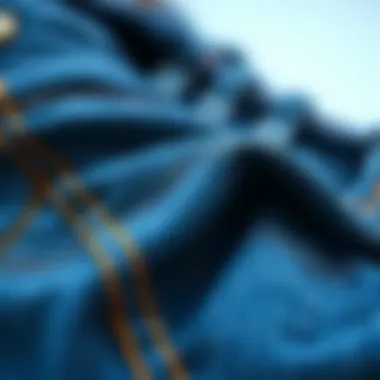
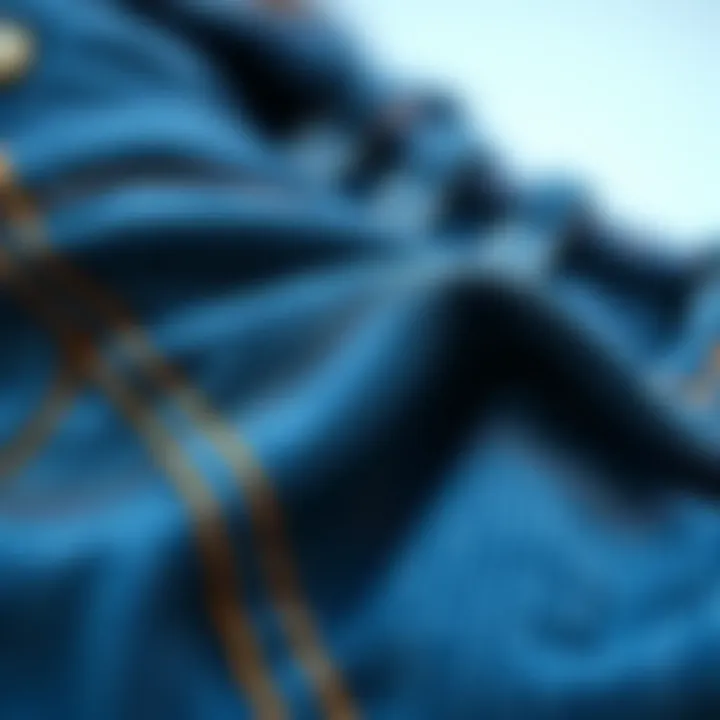
Patterns in denim aren't just aesthetic flourishes; they serve as a medium of expression for many skaters. From bold geometrics to subtle florals, the variety in designs can reflect personal tastes or even cultural influences. Skateboarders often gravitate towards unique patterns as a means to distinguish themselves from the crowd.
Some prevalent types of patterns include:
- Geometric Shapes: Simple yet eye-catching, they catch the eye without overwhelming the senses.
- Abstract Designs: These can convey complex ideas or emotions, often making a statement without the wearer having to say a word.
- Print Collaborations: Brands often team up with artists to create one-of-a-kind designs, adding a deeper layer of meaning to the fabric.
In understanding patterns, we also need to acknowledge the technical aspects of denim. The weaving techniques used can significantly alter how colors and designs appear. This brings about a tactile element, enriching the visual experience. The right pattern can transform standard jeans into conversation starters, allowing wearers to flaunt their personality on and off the board.
Cultural Significance of Patterns
Patterns in denim resonate deeply within the skateboarding community. They serve not just as a fashion statement but also as symbols of identity and inclusion. When skaters wear patterned denim, they're often showcasing their affiliation with a particular group or subculture. This can be particularly important in a community that thrives on self-expression and individuality.
"The threads we choose to wear can speak volumes about who we are and who we want to be in the skating world."
Patterns can also evoke nostalgia or signify movement towards progressive ideas. Vintage aesthetics often make a comeback in skate culture, enabling the rebirth of styles that blend modern sensibilities with historical roots.
Moreover, patterns can carry certain cultural connotations, such as:
- Hometown Pride: Specific prints may symbolize local skate spots or regions, forging a connection between wearers and their roots.
- Artistic Endeavors: Some patterns are inspired by local graffiti artists or famous skateboard graphics, resonating with the artistic essence of the community.
- Subculture References: Designs drawn from punk, hip hop, or even alternative fashion movements speak to the diverse influences that skate culture absorbs.
In summary, the aesthetic journey through patterned denim is layered and complex. It intertwines personal expression, cultural significance, and technical mastery, making it a vital aspect of skate culture. As skaters continue to adapt and innovate, these patterns will undoubtedly evolve, reflecting the shifting tides of both style and societal influences.
Impact of Skate Culture on Fashion
The influence of skate culture on the fashion industry is more profound than many outside observers might realize. From baggy jeans and oversized T-shirts to vibrant sneakers and graphic hoodies, the unique style of skateboarders has shifted mainstream trends over the years. Skate culture isn’t just a subculture; it’s a pervasive force shaping how people express themselves through fashion.
As skateboarding evolved, it also birthed a distinct aesthetic that resonated with the youth, young adults, and even fashion moguls. The importance of this topic cannot be understated, as it highlights how the intersection of sport and style transforms consumer preferences, cultivates community identity, and promotes creativity in everyday attire.
- Consumer Behavior: The skateboarding community tends to favor practicality without sacrificing style, leading to a rise in demand for durable yet fashionable clothing. This trend influences what brands develop and promote, steering them towards functionality and unique designs.
- Community Identity: Skate culture promotes a sense of belonging and personal expression. The choice of denim and other garments contributes to a shared identity, allowing skaters to showcase individuality while also embodying the larger community ethos.
In this article, we will explore these aspects further, delving into specific trends that skateboarders have shaped in contemporary fashion.
How Skateboarders Influence Trends
Skateboarders are often at the forefront of fashion innovation. They don’t just follow trends; they create them. Not only do pro skaters endorse certain brands, but they also serve as trendsetters themselves.
- Social Media Impact: Platforms like Instagram and TikTok allow skaters to share their everyday looks and vibes, influencing other individuals who aren’t even avid skateboarders. A casual skate session or a new trick can turn a simple outfit into a viral sensation, thus pushing brands to adapt their collections accordingly.
- Collaborations: Major brands like Vans, Supreme, and Nike SB actively collaborate with skateboarders to design limited-edition lines that highlight the essence of skate culture. These partnerships not only promote the brand but also withhold the authenticity that the skate community values. These limited runs are often absorbed quickly, showcasing the immense pull of skate fashion.
Through these influences, skateboarders serve as an active force in shaping the broader fashion landscape. Their movements, tricks, and lifestyle choices influence what not only looks good but functions effectively under the harshest of conditions.
Denim as a Canvas for Expression
Denim represents more than just fabric; for skateboarders, it’s a canvas for personal stories and artistic expression. Patterned denim, in particular, allows skaters to tell their own tales through style and aesthetics.
- Customization: Many skaters choose to customize their denim outfits with patches, paint, or fraying—transforming standard jeans into one-of-a-kind pieces. Each modification carries a story, whether it’s a memory of a particular skate session or a reflection of personal struggles.
- Style Diversity: Skate culture embraces a broad spectrum of styles, from grunge to sophisticated streetwear. Denim is versatile enough to adapt to these varied styles, making it a staple in any skater's wardrobe.
The ability to wear denim in ways that reflect one’s personality is what makes it so appealing. Skateboarders, often perceived as avant-garde in their styling choices, show the fashion world the importance of individuality, thereby reinforcing the idea that fashion serves as a medium for self-representation.
"Denim is not just clothing for us. It’s a way to express who we are and what we believe in. It’s our armor in the skate world."
The Practicality of Patterned Denim in Skating
Patterned denim is not just a fashionable choice among skateboarders; it serves several practical purposes that contribute to a skater's overall experience and functionality. The balance between aesthetics and performance is critical in this subculture, as skaters often find themselves navigating challenging environments. The right denim can provide not only comfort but also durability, ensuring that the jeans can withstand the rigors of skateboarding.


Durability and Functionality Considerations
When it comes to skating, durability is paramount. Skateboarders perform tricks and navigate urban terrain that can wear down clothing at an alarming rate. Patterned denim, unlike traditional fabrics, often includes a higher percentage of cotton blended with synthetic fibers. This combination offers both flexibility and strength. Skaters enjoy the unique designs that patterned denim provides, but they also appreciate the practicality of a fabric that can survive falls and scrapes, such as:
- Reinforced stitching: Many brands incorporate reinforced seams in areas that face the most stress, helping to prevent rips and tears.
- Durable fabric compositions: Some denim is treated to repel moisture and dirt, offering a level of protection that standard jeans may lack.
- Stretch factors: The inclusion of elastane or spandex allows for a better range of motion, essential for executing tricks without feeling restricted.
A skater's need for durability without sacrificing style is a driving force behind the popularity of patterned denim, making it a staple in their wardrobe.
Performance Features of Modern Denim
Modern advances in textile technology have transformed how denim is designed, especially for the skateboarding community. Here are some key performance features that set contemporary patterned denim apart:
- Breathability: New manufacturing techniques allow for enhanced breathability, ensuring that skaters remain comfortable even during intense sessions.
- Innovative washing techniques: Methods like stone-wash or enzyme-wash not only create unique patterns but also soften the fabric for added comfort.
- Moisture-wicking capabilities: Certain brands have incorporated moisture-wicking technologies into their denim, contributing to dryness and comfort during extended wear.
"The blend of functional fabrics with trendy patterns is what gives today’s skaters a competitive edge in style and comfort."
As the skate culture continues to evolve, the synergy between function and fashion remains vital. The practicality of patterned denim is not just about looking good; it encapsulates the spirit of skating where innovation meets artistic expression.
Popular Patterns in Skateboarding
The significance of popular patterns in skateboarding lies not only in their aesthetic appeal but also in how they serve as a form of expression within the skate community. Patterns in denim have evolved to reflect identities, preferences, and cultural movements among skateboarders. They are not just styles but rather visual representations of individual attitudes and group dynamics, contributing greatly to the identity of skaters. Understanding these patterns can provide insight into how different styles can merge functionality with personal expression, creating an avatar that resonates deeply with the urban lifestyle surrounding skateboarding.
Geometric Designs: A New Trend
In recent years, geometric designs have carved a niche for themselves in the skate culture tapestry. These bold, angular patterns reflect the sharp lines and sometimes chaotic nature of skateboarding itself. Skaters tend to favor pieces that stand out in a crowd, and geometric designs speak to that desire.
- Visual Impact: These patterns are striking, often employing vibrant colors and intricate shapes that catch the eye. This visual allure makes them a popular choice for both casual skaters and those who participate in competitive events.
- Symbolism: Geometric patterns often denote modernity and are seen as a way to push the envelope of what denim can look like. It hints at a cultural shift that embraces abstract thinking and creativity amid urban settings.
- Durability: Many brands are now creating denim with geometric prints that also focus on fabric resilience, essential for being able to withstand the wear and tear that comes with skating activities.
Vintage Patterns and Their Revival
There has been a resurgence of interest in vintage patterns, as they embody nostalgia and authenticity. The revival of these styles taps into the cultural lineage of skateboarding, recalling simpler times when skate culture was first budding.
- Cultural Link: Vintage patterns can serve as a connection to the foundational years of skateboarding. Icons from the 70s and 80s often incorporated patterns that tell a deeper story about the culture's evolution. Wearing such styles can feel like paying homage to those who paved the way.
- Timeless Appeal: Unlike fleeting fashion trends, vintage patterns have a longevity that makes them a staple item. They provide an edge of retro style while remaining versatile across various settings, making them popular with a wide range of skaters.
- Sustainability: As sustainability becomes a pressing issue, opting for vintage denim signifies a move towards eco-conscious fashion choices. Using existing materials rather than producing new is a step towards reducing waste, further enhancing the appeal for the modern skater.
"In the chaotic rhythm of skate culture, patterns, both new and old, tell stories of individuality and community."
As skaters continue to intertwine their identities with their clothing, the patterns selected serve as a pivotal part of how they communicate their place within the sport and community. From geometric freshness to vintage classics, these styles represent the spectrum of skate culture itself.
Consumer Preferences in Skate Denim
The choice of denim jeans is critical in the skate culture, as they represent not just a fashion statement, but also a reflection of personal identity and authenticity. Skateboarders seek out denim that resonates with their lifestyle, impacts their performace on the board, and showcases their individuality. The evolving tastes of skaters provide valuable insight into the importance of consumer preferences and how they shape the market.
A few key elements influence what skaters look for in denim:
- Comfort and Flexibility: When it comes to performing tricks and stunts, the ability to move freely is paramount. Skate jeans often feature a bit of stretch, allowing for ease of motion without sacrificing style. Not only do skaters desire durability, but they also need their pants to lighten the load of physical demands during a session.
- Durability: Skateboarding can be tough on clothing due to falls and abrasive surfaces. High-quality denim that is reinforced, particularly at the knees and seat, plays a big role in a skater’s preference. No one wants to be left with shredded jeans after a single run.
- Design and Aesthetics: Patterns, colors, and cuts matter. Skaters are known for their unique styles, which often reflect current trends or individual tastes. The appeal of patterned denim can be traced to its ability to differentiate and express oneself in a community driven by personal expression.
- Functionality: Features such as pockets, fits, and moisture-wicking elements are particularly appealing. Skaters appreciate designs that not only look good but can also accommodate various needs while skating.
"Denim choices often merge creativity with function, making it a dynamic topic that reflects the personality of its wearer."
As styles evolve, what skaters demand from their denim continues to change. Whether it be the emergence of eco-friendly materials or the popularity of certain patterns, retail trends react to what skakers want which is vital for brands aiming to cater to their audience.
Exploring these elements provides invaluable insight into the underlying factors that color consumer preferences in skate denim. By understanding these needs, brands can better navigate the landscape of skate culture and engage with its ever-changing dynamics. It’s not just about wearing denim; it’s about expressing a lifestyle and making choices that resonate deeply with one’s identity.
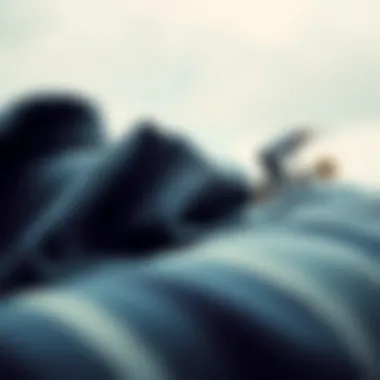

What Skaters Look for in Denim Jeans
When skaters are on the hunt for denim jeans, several specific attributes come to the forefront. First and foremost, the fit can make or break a pair of jeans. Many skaters prefer a relaxed or slim fit that does not restrict movement, while others may choose a tapered leg that offers a contemporary take on classic looks.
Visibility of the style element can also influence preferences. Skaters might gravitate towards skinnier styles because they pair well with various footwear, ensuring that their choice in shoes can still shine through.
Additionally, the weight of the material matters. Heavier denim fabrics, while more durable, could feel restrictive during activity. On the other hand, lighter materials might offer more comfort but run the risk of less durability. Balancing these factors is a delicate equation for skaters.
The Role of Celebrity Influence
In modern society, celebrity endorsements and fashion statements have tremendous clout. For skate culture, this connection is particularly evident. When well-known skateboarders or influencers showcase a specific brand or style of denim, it can shift public perception almost overnight.
Brands understand the impact of this exposure and often collaborate with these figures to gain legitimacy. The inclusion of recognizable figures can create buzz around a new denim line, making it more appealing to another generation of skaters who aspire to emulate these icons.
For example, the denim line of Tony Hawk, or the collaborations by Nyjah Huston, underscore how celebrity choices influence skaters’ preferences. It’s not just the jeans being sold; it’s a lifestyle promise. The presence of these beloved figures can drive sales and make a distinct pattern more desirable simply because they represent authenticity within the culture.
As a result, skaters are hyper-aware of what is being worn by their idols in both skateparks and on social media. The cyclical nature of fashion means that as trends resurface, often it is these influential figures who breathe new life into them, continually shaping consumer preferences in skate denim.
Environmental Considerations
In the realm of skate culture, denim has evolved beyond merely being a fabric choice; it represents a lifestyle and an ethos that ramps up the importance of sustainability. As skateboarding becomes more mainstream, so too does the responsibility woven into its fabric—literally. The environmental impact of denim production and disposal is a pressing concern, particularly given that traditional methods can be resource-intensive and heavily polluting. Acknowledging this, the skate community is increasingly leaning towards practices that promote sustainability.
Sustainable practices in denim production are gaining traction in the industry. Brands like Levi’s and Patagonia have pioneered pathways towards more eco-friendly materials and production processes. For instance, some companies are now utilizing organic cotton and employing water-efficient dyeing techniques. Such practices not only reduce the carbon footprint of denim but also appeal to the values of skaters, who often advocate for preserving the environment. In this way, denim becomes a kind of canvas for expressing both style and social consciousness.
Furthermore, several skate brands are weaving recycled materials into their denim offerings. By incorporating post-consumer waste into their fabrics, these brands not only reduce landfill contributions but also create unique patterns and stories behind each piece. Such innovations align perfectly with the concept of denim as an expression of individuality.
"We’re not just wearing denim; we’re wearing our values. In every fray and fade, there’s a story of sustainability and community."
The Impact of Fashion Choices on Sustainability
The choices made by skateboarders around fashion resonate deeply with sustainability. Each ripped seam and splatter pattern often has a tale of its own, and in a world where fast fashion reigns supreme, the impact of fashion choices on sustainability is monumental. Skaters often prefer to curate their wardrobe to reflect not just personal taste but also their stance on important issues.
This intentionalism can give rise to a more conscious consumer base. For instance, when someone decides to invest in a pair of high-quality, sustainably-produced jeans rather than cheaper, mass-produced versions, they are effectively rejecting a cycle of waste. Instead of discarding clothes after a few wears, individuals are empowered to find ways to repair and prolong the life of their denim, thus fostering a mindset of durability rather than disposability.
Additionally, the influence of social media cannot be overlooked. Many skaters and influencers use platforms like Instagram and TikTok to spotlight brands committed to sustainable practices, thereby guiding their followers toward more eco-friendly choices. This shift not only raises awareness about denim production’s ethical implications but also creates a ripple effect through follower communities.
In summary, the environmental considerations in denim production and consumption showcase a nuanced interaction between skate culture and sustainability. By focusing on sustainable practices and the impact of their fashion choices, skaters are not only shaping their identity but also contributing to a greater movement towards responsible consumption.
The Future of Patterned Denim in Skate Culture
The evolution of patterned denim within skate culture is not just a fleeting trend—it's a window into the shifting nature of self-expression and identity within the community. Understanding the trajectory ahead yields insights not only into fashion but also into the broader cultural dynamics at play among today’s skateboarders. As skate culture continues to grow and diversify, so too does the influence of patterned denim, shaping the ways individuals express their skater identities and navigate urban environments.
In this realm, the future of patterned denim involves several crucial elements. Innovation in fabrics is paramount, with brands increasingly exploring materials that offer superior performance without sacrificing style. Skateboarders need jeans that can withstand the physicality of their sport, while also reflecting their aesthetic preferences. Therefore, a blend of durability and design becomes an essential consideration. Not only are brands looking to use materials like recycled denim and stretch fabrics, but they're also integrating technologies that improve comfort and moisture management.
Moreover, the importance of sustainability in fashion cannot be overstated. The conversation around eco-friendly production methods is picking up steam, which is vital for an audience that values authenticity. Skateboarding often champions counter-culture ideals, making it natural for brands to align themselves with sustainable practices. By enhancing the longevity of denim through careful production techniques, brands respond to the modern consumer's desire for both individual expression and environmental responsibility.
Emerging Trends in Fabrics and Styles
As we look forward, several emerging trends are shaking up the landscape of fabrics and styles in patterned denim. These innovations pave the way for a future where skaters are not just consumers but also active participants in shaping this fashion narrative.
- Eclectic Prints and Textures
Patterned denim is evolving beyond basic graphics. Expect to see eclectic prints that cater to an increasingly diverse representation within skate culture. Styles may draw from cultural motifs, street art influences, or even abstract designs that push the boundaries of traditional denim aesthetics. - Technological Advancements
With the rapid advancements in clothing technology, companies are rolling out denim infused with anti-odor, stretch, and moisture-wicking properties. These features are perfect for skaters who need to look stylish while ensuring maximum performance when they hit the park or street. - Personalization
Personalized denim styles are anticipated to grow in popularity. Skate brands might start offering customizable patterns, allowing skaters to mix and match elements that resonate with their individual identities. In a world where every detail matters in expressing oneself, this personalization aspect could define future purchase decisions.
Predicting the Next Wave of Skater Fashion
Looking ahead, we can expect the next wave of skater fashion to blend functionality with eye-catching design, making it as much about practicality as it is about aesthetic appeal. The upcoming generation of skateboarders—equipped with a rich history of rebellion and a vision for inclusivity—will demand more from their denim than mere durability.
- Inclusivity Across Sizes and Styles
Current conversations around body positivity will likely impact denim designs, leading to a wider range of sizes and fits that cater to all body types. This shift reflects a longer-term trend in challenging normative perceptions in fashion. - Collaboration with Artists
We could see a surge in collabs with local artists and designers, creating limited-edition patterned denim that tells a unique story. Much like the influence of art in skate parks, these collaborations may lead to pieces that express the vibrant tapestry of local street culture, encouraging skaters to wear their identity on their sleeves—literally. - Tech Integration
Expect garments that might feature elements of tech, such as integrated pockets for smartphones, or even fabrics that could change color based on temperature. We’re no longer just talking about jeans; these garments could evolve into multi-functional pieces that blend style with the necessities of a skater’s lifestyle.
These possibilities signal a vibrant future not just for denim within skate culture but for the culture itself. The ongoing dialogue between fashion and function will continue to challenge old paradigms, ensuring that patterned denim remains an integral part of skateboarder identity as they move forward.















